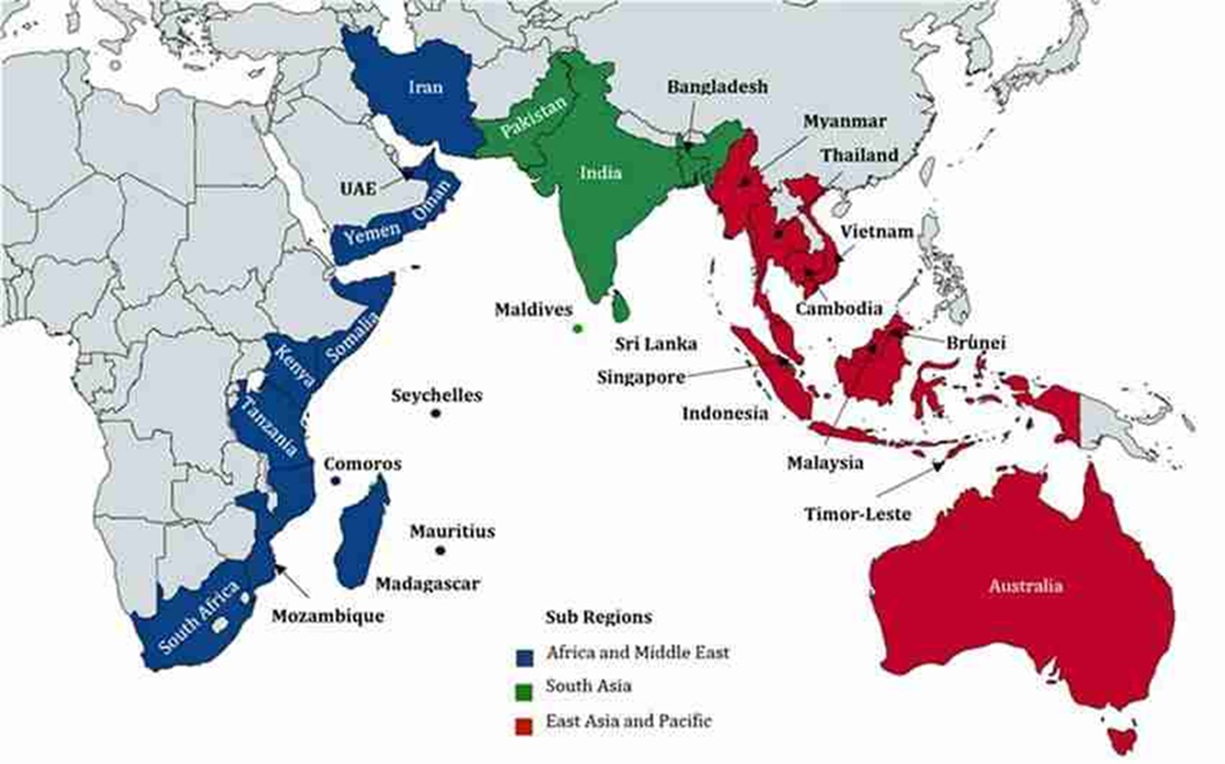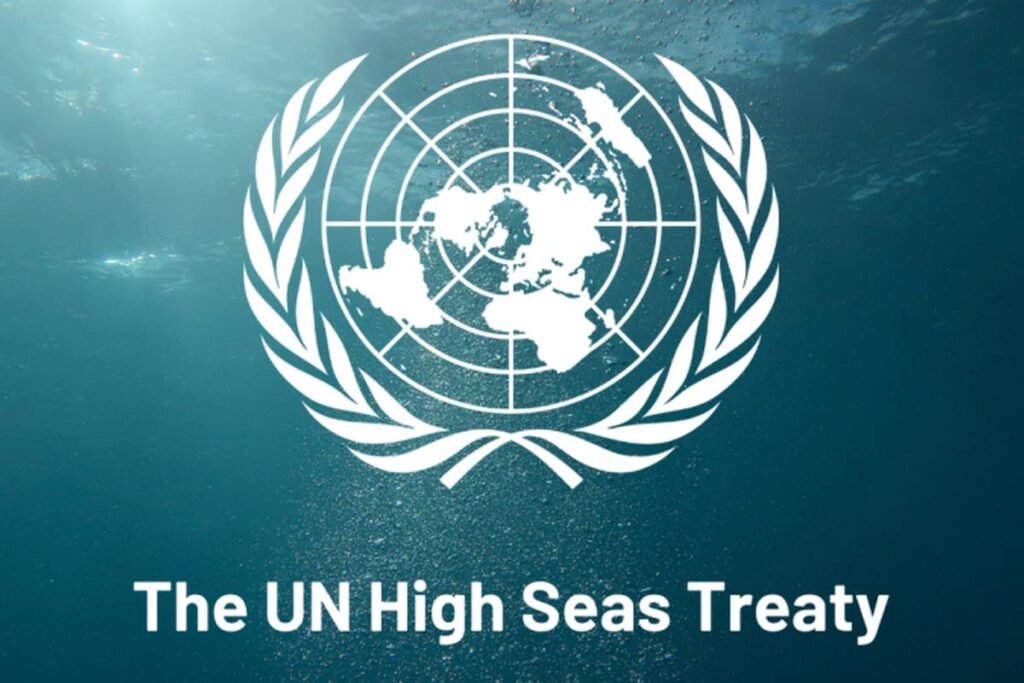The “Treaty of the High Seas”, is an international agreement on the conservation and sustainable use of marine biodiversity of areas beyond national jurisdiction.
United Nations Convention on the Law of the Sea (UNCLOS) 1982, since its coming into being has established a mechanism for, inter-alia, governing marine and maritime activities, including freedom of scientific research, the exclusive economic rights of countries and reducing pollution. Various maritime zones like Territorial Sea (TS), Contiguous Zone (CZ), Exclusive Economic Zone (EEZ) and Continental Shelf (CS) were regulated/ managed by the respective Coastal States. However, the high seas (sea areas outside any nation’s EEZ/ CS) were beyond the jurisdiction of any nation and have long been a blind spot with regard to many activities under UNCLOS.
Towards regulation of these high seas also known as Areas Beyond National Jurisdiction (ABNJ), the initial informal consultations began in 2004 with a UN resolution. Despite the issue being deliberated over a decade, no substantial progress was made. Finally, by virtue of a resolution passed on 24 December 2017, the UN General Assembly decided to convene an intergovernmental conference to elaborate on the text of an international legally binding instrument to regulate ABNJ.
The Agreement to protect biodiversity on the high seas known as Biodiversity Beyond National Jurisdiction Treaty (BBNJ Treaty)1, was finally endorsed by 200 countries (including India) on 04 Mar 23. BBNJ Treaty is considered to be the most significant multilateral maritime environmental convention since the Paris Climate Agreement of 2015. The BBNJ Treaty provides under the UNCLOS, an obligation to protect and preserve the marine environment as also it spells out a comprehensive global regime to better address the conservation and sustainable use of marine biological diversity in ABNJ.
The Scope
The scope of the BBNJ Treaty by virtue of the agreed upon text is threefold as stated hereunder:-
a) Geographical Extent. BBNJ Treaty doesn’t affect the rights, jurisdiction and duties of States under the UNCLOS, including the EEZ and the Continental Shelf (CS) within and beyond 200 nautical miles (Articles 3 & 4 of BBNJ Treaty refers). To address the geopolitical issues amongst the participating Countries, ABNJ Treaty provides exit options for areas of geopolitical tension, notably the Arctic and the South/ East China Sea (Article 15 of BBNJ Treaty refers).
b) Maritime Resource. Provisions of the BBNJ Treaty are applicable to Marine Genetic Resources(MGR) and digital sequence information on marine resources of ABNJ. The BBNJ Treaty is not applicable to fishing or other marine fishing-related resources (such as squids, crabs, and lobsters) which in ABNJ would continue to be governed by respective Regional Fishing Management Organisations (Article 8 of BBNJ Treaty refers).
c) Warships and Govt Vessels. BBNJ Treaty does not apply to any warship, military aircraft or naval auxiliary and Govt vessels being used for non-commercial purposes. However, the BBNJ Treaty obligates Parties to act in a manner consistent so far as is reasonable and practicable, with this Agreement wrt warship, military aircraft or naval auxiliary (Article 3 bis of BBNJ Treaty refers).
BBNJ Treaty
During the deliberations of 1982 UNCLOS, the high seas were considered barren due to a lack of technological means to explore the vast unexplored ocean areas. However, with the technological advancements over a period of time, the High Seas are now recognised to be a ‘treasury of irreplaceable biodiversity’ and a ‘provider of crucial ecosystem services’. The BBNJ Treaty would govern the protection of biodiversity and exploitation of seabed minerals in a sustainable manner. The salient of the BBNJ Treaty meriting attention are stated below:-
a) Objective of the BBNJ Treaty has been stated as the conservation and sustainable use of marine biological diversity of ABNJ, through effective implementation of the relevant UNCLOS provisions and further international cooperation and coordination (Article 2 of BBNJ Treaty refers).
b) Towards regulation of ABNJ, four focus areas have been agreed upon through various Articles of BBNJ Treaty:
- Marine genetic resources, including the sharing of benefits from these resources.
- Area-based management tools, such as marine protected areas.
- Environmental impact assessments.
- Capacity-building and technology transfer.
c) The BBNJ Treaty provides for the establishment of seven bodies/ mechanisms for working on the charter of ABNJ:-
- Conference of the Parties (COP) – Primary decision-making body.
- Secretariat – For providing administrative and logistical support/ functioning.
- A Scientific and Technical Body (STB) – Technical multidisciplinary experts nominated by parties and elected by the COP for advisory.
- Implementation and Compliance Committee (ICC) – To facilitate and function towards implementation and compliance.
- Access and Benefit Charing Committee.
- A Clearing House Mechanism that would be managed by Secretariat. It would provide an open-access of information to parties on marine genetic resources, environmental impact assessments (EIAs) and the establishment of marine protected areas.
- Financial mechanism that has a voluntary trust fund, a special fund and a Global Environment Facility (GEF) trust fund that will accept contributions from all states/ public/ private entities and make benefit-sharing payments on behalf of developed countries.
d) Proposals for the establishment of area-based management tools including Marine Protected Areas2, shall be submitted by Parties, individually or collectively, to the Secretariat (Article 11 of BBNJ Treaty refers).
e) ABNJ Treaty creates a process for designating Marine Protected Areas and other area-based tools to safeguard fragile, biodiverse regions. Until now, due to a lack of consensus to collectively manage high seas, numerous ecologically sensitive zones were affected (Article 1 bis of BBNJ Treaty refers).
f) BBNJ Treaty creates new ground rules for environmental impact assessments of commercial activities on the high seas. Prior to launching any significant for-profit ventures on the high seas, nations and companies falling under their jurisdiction are obliged to review and report publicly on possible harm that could result to marine ecosystems and organisms (Article 30 of BBNJ Treaty refers).
g) BBNJ Treaty provides for sharing of scientific knowledge and technologies to developing nations for fulfilling their obligations, gaining access to marine species and ecosystems that are currently beyond their reach, and being full participants in an emerging blue economy (Article 9 of BBNJ Treaty refers).
h) BBNJ Treaty establishes arrangements for equitable sharing of marine genetic resources and takes the form of a legal, internationally binding implementing agreement under UNCLOS.
Key Issues
Upon analysis of the provisions of the BBNJ Treaty, the following issues are relevant:-
a) Naval warships, military aircraft or naval auxiliaries are exempted and thus naval/ military operations in the Marine Protected Areas promulgated in the future would not be affected directly. Research Vessels being operated by Govts (such as CSRVs/ AGIs) would also appear to be exempted from the operation of this BBNJ Treaty.
b) As the BBNJ Treaty is not applicable to CS within and beyond 200 nautical miles, extended CS claims of any country pending with CLCS, upon approval, would not be impacted.
c) As of now, designated Marine Protected Areas exist within the EEZ of various nations. The BBNJ Treaty provides for the identification, establishment, regulation and monitoring of such vulnerable areas in ABNJ.
d) ABNJ Treaty provides options for areas of geopolitical tension, notably the Arctic and the South/ East China Sea to not be governed under the present Agreement (Article 15 of BBNJ Treaty refers).
e) Implementation of the BBNJ Treaty is likely to be a problem area as the process, of regulating Marine Protected Areas on the high seas for ensuring that they are protected, would be developed in future based on deliberations amongst nations.
f) Another issue meriting attention is the exact process for dispute resolution under the ABNJ Treaty which would take shape based on practices of States and adjudication processes.
Title image courtesy: https://www.timeanddate.com/
Disclaimer: The views and opinions expressed by the author do not necessarily reflect the views of the Government of India and Defence Research and Studies
Footnotes
- The Text of the BBNJ Treaty is still under finalisation. The present comments are based on the advanced, unedited, pending paragraph renumbering text as published on the UN website. Although the text would not be altered, the paragraphs would be renumbered and accordingly, the final text would be released.
- These would be areas in ABNJ that would be promulgated after collaboration and consultation with relevant stakeholders for the establishment of Marine Protected Areas. (Article 17 of BBNJ Treaty refers). Marine Genetic Research and other related activities as provided under BBNJ Treaty would be restricted in Marine Protected Areas.








